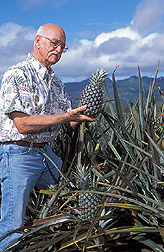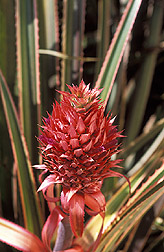This page has been archived and is being provided for reference purposes only. The page is no longer being updated, and therefore, links on the page may be invalid.
Read the magazine story to find out more. |
|
Pineapples Have Fingerprints, Too
By Marcia WoodOctober 3, 2005
Pineapple--sweet, juicy and loaded with vitamin C--ranks as America's fifth-favorite fruit.
In Hawaii, where growers produce about 215 million pounds of fragrant, premium pineapples annually, Agricultural Research Service (ARS) scientists are uncovering telltale stretches of pineapple’s genetic material, or DNA. Then, they’re using the DNA as “genetic fingerprints” to tell who’s who among the plants in the nation’s official collection of pineapples from around the planet.
The DNA-based fingerprints enable scientists and breeders to discern the relatedness of pineapples that are candidates for creating superior new plants for tomorrow. For example, certain pineapple plants might be better able to resist attack by insects or diseases.
Plant physiologist Paul H. Moore and horticulturist Francis T.P. Zee, of the ARS U.S. Pacific Basin Agricultural Research Center on the islands of Oahu and Hawaii, were part of the ARS research team whose studies yielded these DNA fingerprints. The work revealed that each pineapple plant that they sampled from the ARS-managed collection was genetically unique.
Moore leads the ARS Tropical Plant Physiology, Disease, and Production Unit at Aiea, near Honolulu on Oahu Island. On Hawaii Island, in the small city of Hilo, Zee is in charge of the Pacific Basin Tropical Plant Genetic Resources Research Unit and is curator of the genebank there. The researchers and their colleagues documented their findings in a 2004 issue of Genetic Resources and Crop Evolution.
Now, the scientists aim to identify about 1,000 additional, highly revealing lengths of pineapple DNA. These are needed to even further describe the scope of pineapple’s genepool.
The pineapple project is probably the most comprehensive analysis of pineapple genetics yet reported that used a laboratory procedure known as AFLP. An article in Agricultural Research magazine, the ARS monthly journal, tells more.
ARS is the U.S. Department of Agriculture's chief scientific research agency.


